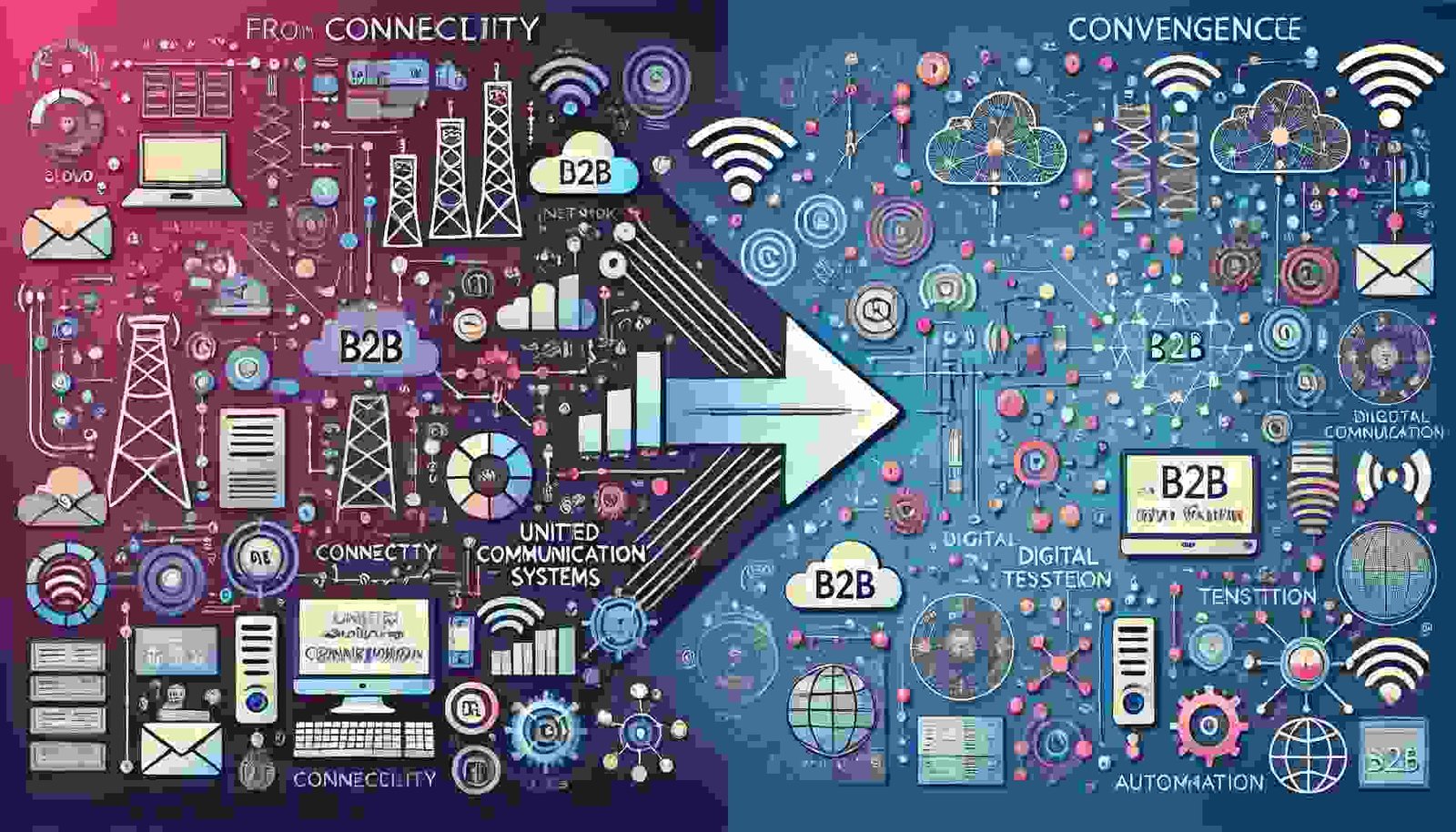Telcos at a Crossroads: Transform from Service Providers to Tech Orchestrators
B2B telecommunications companies are at a pivotal juncture. Traditional connectivity solutions are increasingly commoditized, and customers demand more integrated technology services, including cloud solutions, cybersecurity, data management, edge computing, the Internet of Things (IoT), and business applications. This shift has placed telcos at a crossroads: reinventing themselves from mere service providers to technology orchestrators has become critical for survival and growth.
According to Oliver Wyman, the industry-wide B2B telco revenue share from non-connectivity services has grown by approximately 3 percentage points over the past three years. It is projected to increase by another 4 percentage points in the next four years. This trend is rapidly reshaping the strategic focus of B2B telco incumbents. As Claudio Saes, Practice Leader at Bell Labs Consulting, notes, telcos stand to unlock significant value if they embrace a fundamental shift in mindset towards emerging B2B segments where revenue growth potential is accelerating.
Supporting this urgency, a recent McKinsey pulse survey of over 3,000 B2B tech decision-makers revealed that many telco customers are considering switching their connectivity providers to specialist vendors, attracted by their domain-specific focus and typically lower costs. However, this trend is more nuanced, with small and mid-sized enterprises (SMEs) showing a 35 percent lower intent to switch than larger enterprises.
This evolving customer demand and the growing importance of non-connectivity revenue streams highlight the pressing need for telcos to adopt new operating models that emphasize non-connectivity areas while remaining competitive against specialist vendors in the connectivity space.
To address these challenges, telcos have strong incentives to integrate connectivity services with technology solutions, allowing them to bundle enterprise products and seize upselling and cross-selling opportunities:
- Bundling of Services: Telcos possess valuable infrastructure that enables them to bundle network-centric enterprise products and services, such as cybersecurity, cloud services, unified communications, and managed services. This bundling approach is particularly beneficial for SMEs, which often find themselves “stuck in the middle” as they rely on single-service solutions given their limited internal IT resources, as noted by Bain. Bundling creates integrated solutions, allowing telcos to leverage their existing relationships to cross-sell additional services like IoT solutions, AI-driven analytics, cloud computing, and advanced networking (e.g., SD-WAN).
- Upselling and Cross-Selling Opportunities: In the B2B space, connectivity allows telcos to innovate with new solutions, such as private 5G networks, which can offer differentiated technology offerings tailored to specific industries. As suggested by EY-Parthenon, telcos have increasingly adopted Platform-as-a-Service (PaaS) models, particularly for IoT, Communications Platform-as-a-Service (CPaaS), and multi-access edge computing platforms. CPaaS, closely aligned with their core strengths, has seen telcos primarily serve as network infrastructure providers, with few developing their own API marketplaces. The advent of 5G is poised to drive the next CPaaS phase, emphasizing programmable networks with 5G APIs and B2B2X models, thereby opening new opportunities for telcos to create open API marketplaces.
By integrating connectivity with tech services, telcos can increase the switching costs for their B2B customers, reducing the likelihood of them changing providers. This strategy can lead to more recurring and predictable revenue streams. This is especially true for SMEs, where telcos can position themselves as a one-stop shop and trusted business partner. Ultimately, this strategic shift enables telcos to reposition themselves as tech orchestrators.
Turning the Corner: Forging Alliances to Transform Into a Nimble Tech Orchestrator
As the demand for connectivity services among B2B customers continues to grow, telcos face the challenge of balancing the delivery of essential connectivity services while shifting their strategic focus to newer technologies. This dual responsibility often discourages telcos from investing in improving B2B service delivery, which is crucial for reducing costs and enhancing service quality. To address this dilemma, the industry is exploring innovative ways to enhance the customer experience while cutting costs without making significant additional investments. One promising solution is to partner strategically with specialized vendors and rebadge the service delivery to them, who, although competitors, can offer the expertise needed to elevate the customer experience.
A notable example of this approach is Verizon’s strategic partnership with HCLTech, focused on Verizon’s B2B Managed Network Services unit. This $2.1 billion cost rebadging agreement, spanning six years, enables Verizon Business to concentrate on customer acquisition, sales, solutions, and comprehensive planning and development. At the same time, HCLTech takes over post-sale network deployment and support. HCLTech is set to provide a highly digitized experience, incorporating data-driven service models, enhanced efficiency, and effective lifecycle management, as highlighted in a press release from Verizon.
Kyle Malady, CEO of Verizon Business, emphasized that this partnership will allow Verizon to modernize its service delivery while intensifying its focus on integrating next-generation technologies like 5G, SD-WAN, and SASE for their customers, as reported by CNBC. This strategy enables Verizon Business to continue benefiting from its connectivity services while reducing cost pressures and improving service delivery. According to Reuters, these improvements are expected to generate cost savings within months of the deal’s closure.
With this partnership, customers will enjoy greater control and scalability in their use of network services, improved integration of their broader ecosystem of technology partners, convergence of informational and operational technology (IT/OT) initiatives, and enhanced agility in responding to evolving technology needs, as noted by Business Standard.
Value Around the Corner: Mastering Successful Strategic Partnerships
Telcos often approach transformation projects in separate design and delivery phases, assuming delivery will be straightforward. However, challenges frequently arise during the delivery stage, often after the design team has moved on to other projects, complicating the resolution process. Another common mistake is focusing on specific functions or features without considering their impact on the overall customer journey.
Adopting a cross-functional, end-to-end approach with agile methodologies is crucial to overcome these issues in rebadging transformations with strategic partners. By aligning internal and partner teams around the entire change lifecycle and customer journey, telcos can ensure they have the necessary talent and decision-making power to iterate, scale, and quickly generate value from the strategic partnership. Key principles, such as those outlined by BCG for B2B telco transformations, are also vital when engaging in cost-rebadging deals with strategic partners.
- Adopt a Comprehensive, End-to-End Approach: Focus on the entire customer journey—from order placement to product usage—rather than just individual steps along the way.
- Prioritize the Customer Experience: Gain deep insights into customer needs, preferences, and behaviors to determine what truly resonates with them and what doesn’t.
- Emphasize Value Creation: Identify inefficiencies in current processes and assess the potential benefits of changes. Aim for significant, transformative improvements rather than minor tweaks.
- Build Integrated, Cross-Functional Teams: Form teams that combine all the necessary expertise and decision-making power to design and execute changes. These teams should operate in rapid cycles, continuously gathering feedback and refining each iteration to achieve better results.
As telcos navigate the complex landscape of B2B service delivery, strategic partnerships offer a promising path forward. By leveraging specialized vendors’ expertise through cost rebadging, telcos can focus on core competencies while improving customer experience. This approach, exemplified by Verizon’s partnership with HCLTech, allows telcos to modernize service delivery, integrate next-generation technologies, and achieve cost savings—all critical elements in their transformation from service providers to agile tech orchestrators.
Author Bio:
You can connect with him on LinkedIn.
Read Dive is a leading technology blog focusing on different domains like Blockchain, AI, Chatbot, Fintech, Health Tech, Software Development and Testing. For guest blogging, please feel free to contact at readdive@gmail.com.





